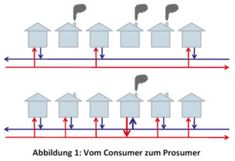BINE
Heat grids are an excellent possibility to integrate renewable energy into general heat supply, which reduces CO2 emissions and other forms of environmental impact. At the moment, however, many locally available heat sources are not used. In addition, there are several problems when operating such grids; e.g. summer operation is almost always a loss-making business. Also control of heat grids is typically implemented in a rather simple way which does not make full use of the potential (e.g. properly incorporating the heat storage capacity of the grid itself). When a grid reaches its capacity limit, conventional expansion typically involves enormous effort.
Therefore it is desirable to integrate all locally available renewable heat sources (solar thermal devices, biomass boilers, waste heat, which may be recycled by use of heat pumps) and in particular push de-centralized heat in-feed. This in-feed can relieve the strain on the grid; loss-making operation modes can be avoided by intelligent de-centralized solutions. At the same time, emissions can be reduced, since for integrated biomass boilers, use of partial load mode and frequent switching on and off are not necessary.
In order to advance this development, the heat-prosumer concept (producer-consumer, i.e. integration of buildings which, at some time feed heat into the grid while extracting heat from it at other times), which has already be treated in a pre-project, will be examined in more detail and will be developed further. This development will include aspects of heat technology, hydraulics, control theory, ecology and economics and will treat them in an integral approach. The focus for this is clearly on use of renewable energy, even though the concepts can also be transferred to heat from arbitrary sources. For these studies, technical calculations, model development, control unit design, simulation studies and experiments with different heat sources in a selected test grid will be used.
Advancing and evaluation of the business model also approaches from game theory, in particular in the context of multi-agent models, will be used.
Heat-technological results will be a criteria catalogue for all examined heat sources and an evaluation of their use in bi-directional grids. As a further result we will have a concept for a robust and efficient control strategy for prosumer integration. In addition, we will have a business model, optimized by simulation studies and evaluated by comparison with other approaches.
http://www.aee-now.at/cms/fileadmin/downloads/projekte/bine/Bine%20Leitfaden.pdf
contact: andreas.leitner@boku.ac.at


